This article is a follow-up to my Rock Island Armory XT 22, Model 51930 .22LR 1911-Based Pistol Part 1 of 3: https://guntoters.com/blog/2017/02/05/rock-island-armory-xt-22-model-51930-22lr-1911-based-pistol-review/ article.
This article focuses on a couple of issues that I have with the pistol and how I have worked around them.
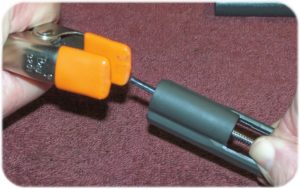
Preparing to Clamp the Recoil Spring Guide
The first issue was that the Recoil Spring Plug (Part No. 2216A) could not be removed from the slide. While I could have used the assistance of a good gunsmith, I decided that this issue was actually something that I could live with. I came up with a disassembly and assembly procedure that works quite well utilizing a “clamping” method” outline in the original article. Unless the Recoil Spring Plug became excessively worn, it really does not need to be removed.
The second issue was with the Barrel Lug Adjustment Screw (Part NO. MIG003) and this issue is a little more complicated. The screw (an Allen-head screw) was tightened fully into the bottom of the barrel lug. This screw, like the Recoil Spring Plug, could not be removed, and in all likelihood, would have been damaged by stripping out the hex-head slot. To better understand the issue, allow me to dive into what the Barrel Lug Adjustment Screw actually does.
Like other 1911-based .22 caliber pistols, the XT 22LR (and I assume that the XT 22 Magnum is similar) utilizes a Slide Stop (Part No. 4506). The pin of the slide stop secures the barrel not unlike that with a standard 1911-based pistol. The Slide Stop also hold the frame rearward, but unlike the standard 1911-based pistol, it is not used to hold back the slide on an empty magazine – unless the pistol is configured to run a standard Government Model .45ACP slide assembly when it actually performs that function.
On a standard 1911-pistol, the Slide Stop pin secures the Swing Link while the barrel rotates from the full-recoil position to the full-battery position. With the XT 22LR slide assembly; however, the barrel is to be as fixed as possible, and which is similar (in principle) to any simply blow-back pistol. To mitigate, as much as possible, pivoting of the barrel around the Slide Stop pin Armscor opted to use a Barrel Lug Adjustment Screw rather than an external screw and pin as is used with the GSG 1911-22 and Sig Sauer 1911-22. Note that the Walther Colt 1911-22 uses a barrel nut to secure the barrel to a barrel mount, which is integral to the frame.
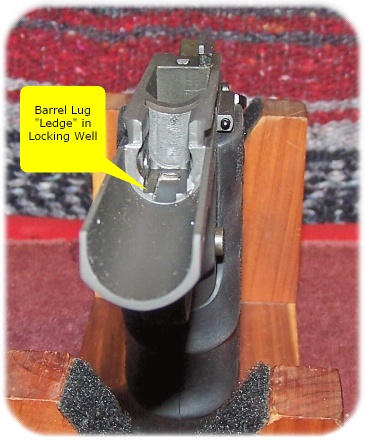
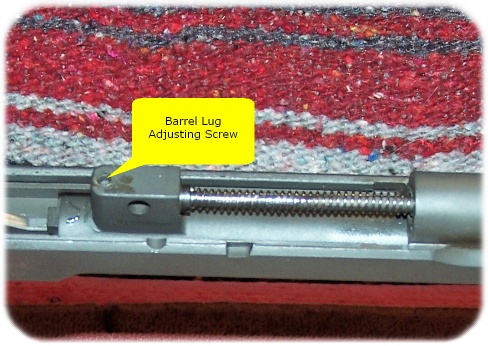 The lug of the barrel slides into a channel in the frame that is milled specifically to accommodate the deeper barrel lug of the XT 22LR barrel. When the barrel is “pinned” by the Slide Stop pin, the barrel lug is raised slightly off of the “ledge” that accommodates the width of the barrel lug. The space between the barrel lug and the ledge is what allows the barrel to rotate ever so slightly on the Slide Stop pin. When properly adjusted, the Barrel Lug Adjustment Screw reduces this rotation since the barrel is now resting on two points (the Slide Stop pin and the Barrel Lug Adjustment Screw) rather than on one point. With that said, the Barrel Lug Adjusting Screw cannot be adjusted to the point that it does not allow the barrel lug to be inserted into its channel; some barrel movement has to be allowed with this setup.
The lug of the barrel slides into a channel in the frame that is milled specifically to accommodate the deeper barrel lug of the XT 22LR barrel. When the barrel is “pinned” by the Slide Stop pin, the barrel lug is raised slightly off of the “ledge” that accommodates the width of the barrel lug. The space between the barrel lug and the ledge is what allows the barrel to rotate ever so slightly on the Slide Stop pin. When properly adjusted, the Barrel Lug Adjustment Screw reduces this rotation since the barrel is now resting on two points (the Slide Stop pin and the Barrel Lug Adjustment Screw) rather than on one point. With that said, the Barrel Lug Adjusting Screw cannot be adjusted to the point that it does not allow the barrel lug to be inserted into its channel; some barrel movement has to be allowed with this setup.
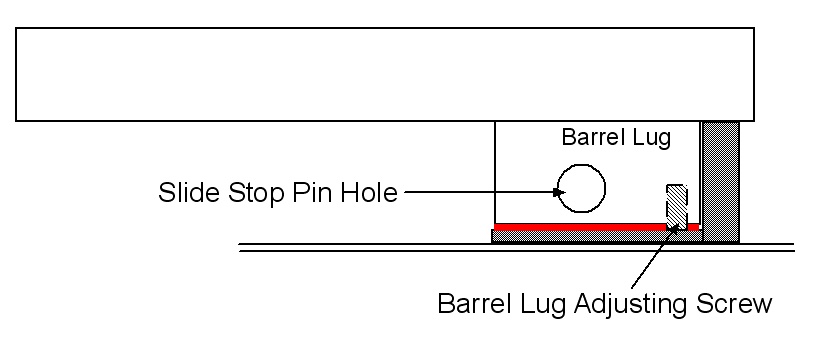 The issue, as I perceived it, was to eliminate as much space as possible between the bottom of the barrel lug and the top of the barrel lug ledge in the frame (shown as red in the above image), yet still allow some movement of the barrel so as not to affect the position of the chamber for loading or binding, in any manner, the barrel against the slide. The solution also had to allow for the Slide Stop to be removed or installed without binding against the inside of the locking hole of the barrel lug. Would adding a shim between the barrel lug and the barrel lug ledge inside of the locking well of the frame work? It was certainly a possibility.
The issue, as I perceived it, was to eliminate as much space as possible between the bottom of the barrel lug and the top of the barrel lug ledge in the frame (shown as red in the above image), yet still allow some movement of the barrel so as not to affect the position of the chamber for loading or binding, in any manner, the barrel against the slide. The solution also had to allow for the Slide Stop to be removed or installed without binding against the inside of the locking hole of the barrel lug. Would adding a shim between the barrel lug and the barrel lug ledge inside of the locking well of the frame work? It was certainly a possibility.
Moving forward, I had to decide upon the type and thickness of the shim. I also did not desire the shim to come loose at any time. First of all; however, what was the necessary thickness of the shim itself? I looked down at my desk, and the possible answer to this question was right in front of me – electrical tape.
I started out with a single layer of electrical tape that was cut to the size of the bottom of the barrel lug and then test-fitted the barrel into the frame with it pinned into place with the Slide Stop pin. The test shim, in my mind, was placing me on the right track.
A second layer of electrical tape was added and I felt that was to be the limit that I was willing to go. But, I had to push that limit just a hair further. This wasn’t rocket science where one is working with exact measurements and dimensions. This was “Billy Bob’s Bargain Basement and Gun Repair Emporium” I was dealing with – otherwise known as “Redneck Engineering.”
Now, I was not going to just use a couple of strips of electrical tape to solve the issue; that would not have any class at all – and I do have a little class left in me – not much, but a little. I had to come up with something better.
Lying in an envelope was a product that I had ordered in the past but never used; a Talon grip for the Springfield XDs. In the center of the Talon grip is a perforated section that is removed prior to installing the tape onto the pistol. The perforated center piece, with some minor trimming, would fit perfectly on the base of the barrel lug. The thickness of the Talon tape would also be adequate for my purposes.
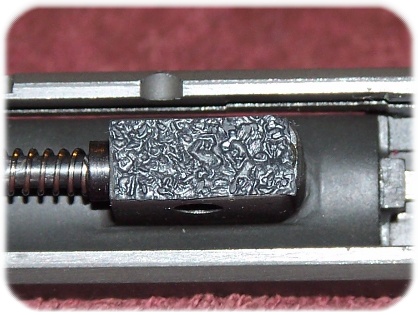
Talon Grip Tape Shim for Barrel Lug
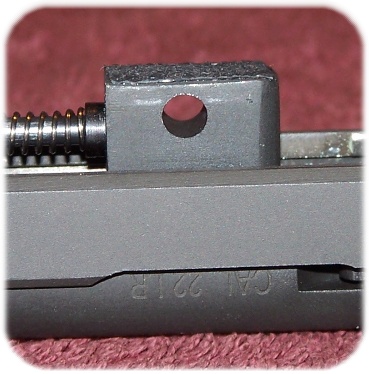
The Shim Helps to Reduce Barrel Movement
The Talon tape was trimmed, installed on the barrel lug, and the barrel test fitted to the frame as before. I had achieved Redneck Engineering perfection! The barrel was removed, mild heat applied to the Talon tape to help secure it, and the RIA XT 22LR was assembled with the “fix” in place.
There is still slight barrel movement at the muzzle end, but an acceptable amount of barrel movement that still allows for proper clearance in all areas of concern. The Talon grip, the rubber version, also “gives” a bit due to its flexible nature. Due to the adhesive backing, I also do not have to worry about “shim shifting.”
To paraphrase Jeff Foxworthy, “You might be a redneck if…you use Talon grip tape to shim a gun barrel.”
Armscor did not approve this message! With that said, I received an e-mail from Armscor wanting their pistol back – for warranty work. With the email was the RMA form and shipping label. It seems that I will be missing the RIA XT 22LR for three to four weeks (according to Armscor), but it is probably for the better. The only question that I have is, should I send it back with the Talon grip tape shim?
THE REST OF THE SERIES:
Rock Island Armory XT 22, Model 51930 .22LR 1911-Based Pistol Part 1 of 3: https://guntoters.com/blog/2017/02/05/rock-island-armory-xt-22-model-51930-22lr-1911-based-pistol-review/
Rock Island Armory XT 22, Model 51930 .22LR 1911-based Pistol Part 3 of 3 – Return to Sender: https://guntoters.com/blog/2017/02/18/rock-island-armory-xt-22-model-51930-22lr-1911-based-pistol-review-part-3/
![]()

